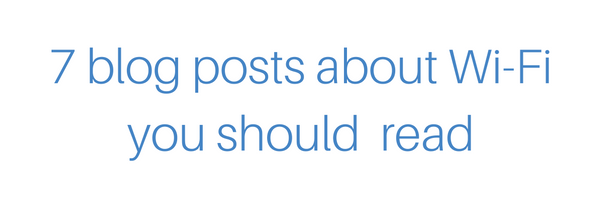
2016 has been a innovative year for the Wireless industry, and this is only the beginning as the market is expected to thrive and the investment in Wi-Fi equipment is likely to triple by 2017.
Tanaza has selected 7 blog posts about Wi-Fi that illustrate how the wireless industry is growing and evolving:
 No Wi-Fi without optimization
No Wi-Fi without optimization
Blog post for WirelessLan Professionals
“How to get the maximum out of your Wi-Fi network: Optimize! “Never touch a running system,” is a widespread sentiment among network administrators and stems from the experiences gained from operating-system updates. The general opinion is: Once a system is set up and configured, think twice about changing it. These days this is a rather negligent approach, as the acceleration in technological development has resulted in constantly shifting needs and requirements. Studies show that the Wi-Fi landscape will undergo severe changes within the next couple of years. The enormous increase in the number of mobile clients has led to unprecedented growth in the data volumes transferred via wireless networks…”
—
 Rogue access point wired into LAN – how afraid should you be?
Rogue access point wired into LAN – how afraid should you be?
Blog post for I love Wifi website
“I’ve been thinking about the fear that some enterprises have about the possibility of someone bringing an access point from home and connecting it into the LAN at work with no security enabled.
Most wireless vendors have a way to determine if rogue access points are actually connected into the wired LAN. Cisco’s WCS has the ability to track a rogue access point on the LAN via RLDP, but it has been problematic for quite some time. Kicking off the RLDP search is a manual task for every rogue SSID that is detected by WCS. There simply isn’t a way for WCS to auto scan the rogue SSID to ensure it isn’t cabled into the LAN. This makes it hard to determine if rogue access points are wired into the LAN or not. Unfortunately enterprises where PCI compliance is mandated, the manual scan will have to be run on every rogue SSID…”
—
 The revolution Wi-Fi capacity planner
The revolution Wi-Fi capacity planner
“I’m sure that we have all experienced poorly designed Wi-Fi networks. When a technology is so ubiquitous, so easily accessible, and is increasingly the most relied upon method of Internet access for mobile devices and cloud computing, then there are bound to be some issues. Unfortunately, the prevalence of underperforming Wi-Fi networks is still much too common for my liking. Great Wi-Fi starts with proper design. There are various approaches to WLAN design that have evolved over time, ranging from providing basic coverage to maximum capacity and situations in-between…”
—
 Public Wi-Fi – Fast, free and easy
Public Wi-Fi – Fast, free and easy
Blog post for WirelessLan Professionals website
“This is a blog post about Public Wi-Fi opportunities. Of course, these are just the opinions of this author. But it comes from interviews with hundreds of customers. Many in the WLAN industry who like to sell solutions to their customers might find the attitudes reflected in these posts as counter to them making more money. But the reasons for this series is to make folks think. Think about how you PERSONALLY would like to access Wi-Fi. So please read and think about how you, your friends, your family, and others you know would LIKE to have access to Public Wi-Fi…”
—
 Wi-Fi takes its place at the heart of carriers’ data strategies, looking beyond offload
Wi-Fi takes its place at the heart of carriers’ data strategies, looking beyond offload
Blog post for Rethink Research website
“The enthusiasm with which mobile operators have embraced data offload to Wi-Fi, as a way to ease the strain on their creaking 3G networks, often obscures the fact that what they are doing remains, for now, highly unsophisticated. Some cellcos have invested large sums in building their own hotspot networks, or connecting to those of partners, but beyond the clear benefit of getting traffic off the cellular system, they are not getting much return. The user experience remains clumsy, without seamless hand-off between 3G and WLan nodes; the hotspots are not usually scientifically planned to mirror the areas of most traffic; operators cannot track user behaviour once the customer has been offloaded, and so lose the chance to monetize; and the link to the unlicensed network may not even be fully secure…”
—
 SSID Overhead – How many Wi-FI SSIDs are too many?
SSID Overhead – How many Wi-FI SSIDs are too many?
Blog post for Revolution Wi-Fi website
“One of the most commonly cited best practices among Wi-Fi professionals is to the limit the number of SSIDs you have configured on your WLAN in order to reduce the amount of overhead on the network and to maintain high performance. But there is not a lot of public data out there to really drive home this point when explaining it to another engineer, management, or a customer. Simply telling someone that they shouldn’t create more than ‘X’ number of SSIDs isn’t very convincing. Therefore, I’ve created a visual tool to help you explain WHY too many SSIDs is a bad thing…”
—
 How do you stage your access points?
How do you stage your access points?
Blog post for Just Do Wifi website
“This blogpost is about my quest to refine my access point staging process. Back in the day, I used to stage the (autonomous) access points in my deployments one by one. It took a long time to configure each one, and I’ve always been on a quest to perfect the perfect staging process. Fast forward to 2014, and I find myself surveying, designing, configuring and installing. With most of my deployments nowadays, I hire Electricians and Telecommunications Technicians to install the access points. However, I still find that staging the access points myself is usually worth the effort. I’m a believer in powering up all access points, “burning them in”, configuring them, and labeling them – long before they ever end up in the Installer’s hands. I guess it is personal preference…”
